#sir bedevere
Text

what happens in camelot, stays in camelot
(happy spamalot opening day!)
89 notes
·
View notes
Text
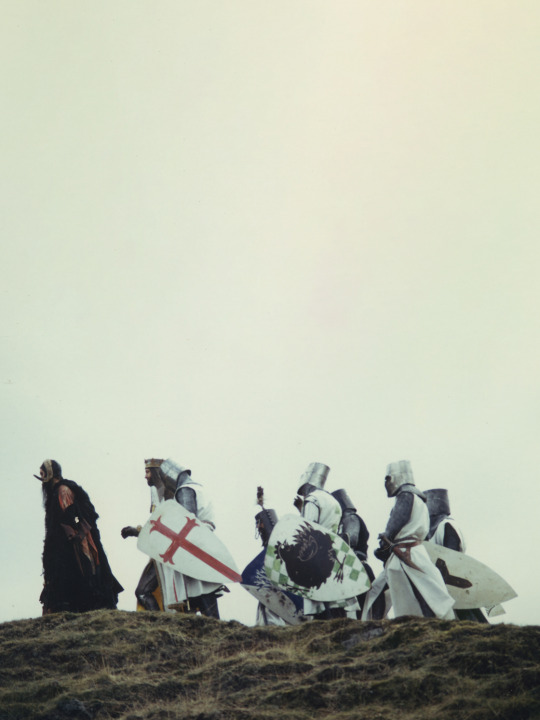
“Follow. But! Follow only if ye be men of valor! For the entrance to this cave is guarded by a creature so foul, so cruel, that no man yet has fought with it… and lived!”
Monty Python And The Holy Grail (1975)
#1975#film#movie#Monty Python And The Holy Grail#John Cleese#Tim The Enchanter#Graham Chapman#King Arthur#Michael Palin#Sir Galahad The Pure#Terry Jones#Sir Bedevere#Eric Idle#Sir Robin The Not-Quite-So-Brave-As-Sir Launcelot#Terry Gilliam#Sir Bors#The Holy Grail#Cave Of Caerbannog#Camelot#Monty Python#knights
49 notes
·
View notes
Text

Sir Bedevere and the witch.

#Monty Python and the Holy Grail#Sir Bedevere#Terry Jones#witch#Connie Booth#newt guy#John Cleese#Eric Idle#Michael Palin
26 notes
·
View notes
Text
I may be having a serious depressive downswing but I’m watching Monty Python’s Holy Grail for the first time in years and the knights’ chainmail is obviously just knitting spray painted silver or gold and that’s what my gram used to do for stage costumes and that makes me smile
#pd alice personal#also wtf is sir bedevere’s accent and why am I imagining Camilla and Palamedes watching this movie and her nudging him like ‘‘it’s you’’
8 notes
·
View notes
Text
if there's one thing i've learned from the few days of nightly knights' existence it's that there are few better feelings than people liking something you made
#like. i'm only really responsible for transcribing texts and writing a little in-character blurb at the top but uhm.#people seem to like sir bedevere from their emails and i like being the one behind sir bedevere from their emails#like 1. i'm showing off one of my all-time favorite things and 2. i'm really enjoying curating this all. like ough i have so many big plans#for emails to send during pride month it's unreal. i used to want to go into library sciences before clothing grabbed me by the throat#and honestly? i still think i'd be damn good at it#romeo.txt
2 notes
·
View notes
Text
SPAMALOT - BROADWAY - JANUARY 2024
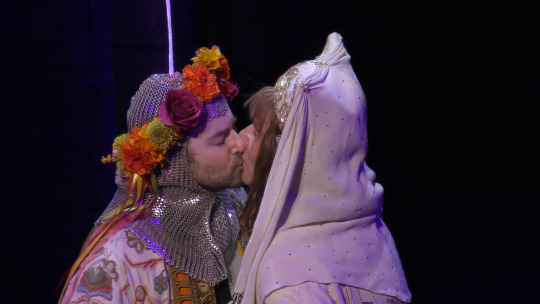
Spamalot | Broadway (Revival) | 2024, January | MP4 (9.39 GB, 2160p) | The Riddle’s master
Cast: James Monroe Iglehart (King Arthur), Leslie Rodriguez Kritzer (The Lady of the Lake), Christopher Fitzgerald (Patsy/Mayor/Guard 2), David Josefsberg (s/b The Historian/Not Dead Fred/Prince Herbert/Bunny), Jimmy Smagula (Sir Bedevere/Dennis's Mother/Concorde), Alex Brightman (Sir Lancelot/The French Taunter/Knight of Ni/Tim the Enchanter), Nik Walker (Sir Galahad/The Black Knight/Prince Herbert's Father), Michael Urie (Sir Robin/Guard 1/Brother Maynard), Daniel Beeman (Ensemble), Maria Briggs (Ensemble), Gabriella Enriquez (Ensemble), Michael Fatica (Ensemble), Denis Lambert (Ensemble), Shina Ann Moris (Ensemble), Kaylee Olson (Ensemble), Kristin Piro (Ensemble), Drew Redington (Ensemble), Olivia Ashley Reed (Ensemble), Tyler Roberts (Ensemble)

Notes: Great 4k capture of Alex Brightman joining the cast, while Michael Urie was still with the cast, with David Josefsberg on as a vacation cover. Some spotlight washout (mostly in wideshots) and some obstruction from heads and a railing. Zooms are unaffected.
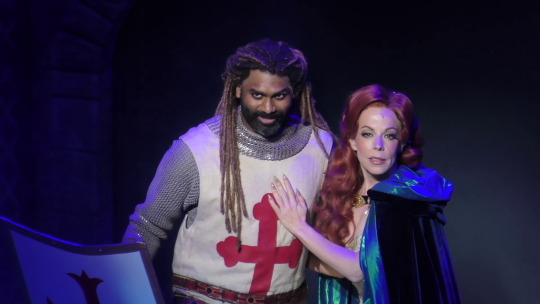
NFT DATE: AUGUST 1, 2024
Sales only until NFT date; price is $18
email [email protected] if interested
Screenshots: https://flic.kr/s/aHBqjBarV5
43 notes
·
View notes
Text
JUNE RELEASE!

Monty Python's Spamalot - Kennedy Center
May 18, 2023 - Medium Observation
Video | Matinée
Cast:
James Monroe Iglehart (King Arthur), Leslie Rodriguez Kritzer (The Lady of the Lake), Matthew Saldivar (Patsy/Guard 2), Rob McClure (The Historian/Prince Herbert), Jimmy Smagula (Sir Bedevere/Dennis's Mother/Concorde), Alex Brightman (Sir Lancelot/The French Taunter/Knight of Ni/Tim the Enchanter), Nik Walker (Sir Galahad/The Black Knight/Prince Herbert's Father), Michael Urie (Sir Robin/Guard 1/Brother Maynard), Michael Fatica (Ensemble), Kaylee Olson (Ensemble), Ryan Kasprzak (Ensemble), Phillip Attmore (Ensemble), Daniel Beeman (Ensemble), Maria Briggs (Ensemble), Eloise Kropp (Ensemble), Daniel May (Ensemble), Shina Ann Morris (Ensemble), Kristin Piro (Ensemble)

Notes:
Nice video of this hilarious show. Filmed from the orchestra. Lots of wideshots, which can lead to some washout at times. Beautiful zooms however on the cast (Alex Brightman fancam at times but it never takes away from the video!). Overall a great video of this Hilarious and perfect production.
NFT Date: December 1, 2023

Screenshots: https://flic.kr/s/aHBqjAEn7m
Video is $20

Hadestown - First US National Tour
May 20, 2023 - Medium Observation
Video | Matinée
Cast:
Colin LeMoine (u/s Orpheus), Hannah Whitley (Eurydice), Matthew Patrick Quinn (Hades), Nyla Watson (u/s Persephone), Nathan Lee Graham (Hermes), Belén Moyano (Fate 1), Cecilia Trippiedi (u/s Fate 2), Dominique Kempf (Fate 3), Racquel Williams (Worker), Jemal Lee Harris (Worker), KC Dela Cruz (s/w Worker), Ian Coulter-Buford (s/w Worker)
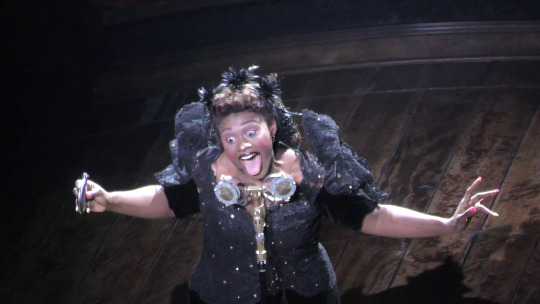
Notes:
Fantastic video of Colin's Orpheus Debut! there is a small head obstruction in the far left bottom that obstructs nothing but Hermes legs at times. This was a very unique and stressful show for the cast as they were down a worker and had everyone in the company on in the show. the show started almost 25 minutes late as they had to rehearse and change choreo. The lights hit in wait for me and the choreo change is quite fun to see and it's unique!
NFT Date: December 1, 2023

Screenshots: https://flic.kr/s/aHBqjAEEBp
Video is $20

Beetlejuice - First US National Tour
February 19, 2023 - Medium Observation
Video | Matinée
Cast:
Justin Collette (Beetlejuice), Isabella Esler (Lydia Deetz), Britney Coleman (Barbara Maitland), Will Burton (Adam Maitland), Jesse Sharp (Charles Deetz), Kate Marilley (Delia Deetz), Danielle Marie Gonzalez (Miss Argentina), Abe Goldfarb (Otho), Brian Vaughn (Maxie Dean), Karmine Alers (Maxine Dean/Juno), Jackera Davis (Girl Scout), Matthew Michael Janisse (s/w Ensemble), Ryan Breslin (s/w Ensemble)

Notes:
Big head obstruction on the left side of the screen where the crib, and Charles room is. it's worked around fine, but it's there and can be very distracting at times. besides that it's a great 4k video and it's a unique one, because they had asl and captions so the cast had to stick on script, which led to some fun choreo improv!
NFT Date: December 1st, 2023

Screenshots: https://flic.kr/s/aHBqjAsYaU
Video is $10
Videos can be purchased through me at [email protected]
110 notes
·
View notes
Text
Arthurian myth: King Arthur (1)
Loose translation of the article "Arthur (Artus)" from Catherine Rager's "Dictionnaire des fées et des peuples invisibles dans l'Occident païen" (Dictionary of fairies and invisible people in the Pagan Occident).

ARTHUR (Artus)
Mythical king of a cycle of romans, the tales of the Round Table, also known as the Matter of Britain, which blossomed throughout all of Europe from the 12th to the 15th centuries. Among those texts, we find numerous romans by Chrétien de Troyes, and The History of the Kings of Britain by Geoffroy of Monmouth, alongside its very loose translation Le Roman de Brut by Wace, itself rewrote by the priest Layamon in his poem Brut, and later, by Malory in his La Mort d'Arthur. Arthur was originally a historical warlord killed around 537 at the battle of Camlann, but he then became a super-human character identified to another Arthur, the great god of the pantheon of the Britons, and thus symbolizing the fight of the old kings of Great-Britain against the Saxon invaders.
The father of Arthur is the king Uter Pendragon who, despite his human appearance, seems to be a figuration of an Underworld king. He claims to be Constantine's descendant - the Celts, during this era, were Romanized. Arthur's half-sister is the fairy Morgane. As for his wife, the incomparable Guenievre ou Guinevere, her name means in its Welsh form (Gwenhwyfar, Gwenhwyvar) "white spirit", "white ghost". Some considered that Guenievre, who is recurringly kidnapped, is a resurgence of the Greek goddess Persephone. Their son, Llacheu, has the gift of second-sight/clearsight, as he knows the secret of material elements and of nature.
The relationships between Arthur and the Otherworld make him a magical character. In the roman of the Saxon Layamon, Brut, we see elves assist to his birth and gift him - he will be powerful, wealthy, generous and have a long life.
As many other heroes, Arthur receives his sword, Excalibur, from a supernatural creature. It is the Lady of the Lake that offers it to him. Indeed, the weapon he took away from its rock had been broken during a previous battle. Merlin, to replace it, brought the king to the shore of a lake, where an arm with white silk came out of the water, offering him the magical sword ornate with dragons - it is Excalibur, the Caladbolg of the Irish Fergus, a sword forged in Avallon. Before his death, the king will task sir Bedevere with bringing back Excalibur to the lake, where the mysterious arm appears again out of the water and takes it back. The Lady of the Lake always offers her protection to the king.
Arthur rides a black horse, a color associated to the realm of the dead: he can, as such, cross the waters that separate the afterlife from the realm of the living without his horse going wild with terror. The Book of Taliesin, a Welsh text of the 13th century, tells how the king went to the Underworld and brought back from it a magical cauldron (prefiguration of the Grail) which offers to knights an endless supply of food, but stays empty for the cowards.

Arthur is a purifying hero who gets rid of the monsters that plague the universe, just like Hercules, Theseus, Finn mac Cumhail or Cûchulainn. His first exploit was to kill the boar Twrch Trwyth which was ravaging Wales (Mabinogion of Kulwch and Olwen).
Once king, Arthur represents a solar-themed strength and wisdom. Advised by Merlin the enchanter, he establishes a rule of peace and justice (for twelve years according to some, for forty according to others), and presides at Carduel the Round Table, whose nature confirms that Arthus is both belonging to the supernatural, and an image of the Sun. His court can be found at Camelot - which might be Cadbury Castle, in the Somerset, but is before all the idealized town, the perfect city, the seat of knowledge, poetry and alchemy. The court keeps moving depending on the tales. The lord regularly sends his knights fight for just causes (and, after the Christianization of the legend, for the quest of the Grail containing the blood of the Christ), but himself rarely appears as a warrior. He sometimes even appears to figure a god of war who is above the mere battle, similarly to the goddess Badb.
For a marvelous life, a prodigious end: in his Vita Merlini, Geoffroy of Monmouth tells how the king, killed by the treacherous Mordred, his nephew and likely incestuous son, is carried on a magical boat by fairies that came from the Atlantic (where the realm of the dead is located). He is accompanied there by the Lady of the Lake and by three queens: the queen of Northern Wales, the queen of the Terre Gaste, and Morgane. Healed of his wounds by the latter, he stays with her, the Lady of the Lake, and their six sister-fairies, in the island of Avallon, "The Isle of Apples", which is sometimes a name for the Sidh/realm of the fairies, sometimes synonymous with the Blessed Islands or Fortune Isles. In Layamon's Brut, it is elves that take to Avallon the dead king, and it is the elf-queen Argante that brings him back to life. In truth, he returned to the place he belongs to, this Otherworld where there is no death, no suffering, no decadence, but only youth, feast and joy. His people hope for his messianic return, either in times of war, or simply so that he can offer them wise advice. In Cornwall, king Arthur supposedly appears in the shape of a black bird with red-colored beak and claws.
Old texts from which Rabelais took his inspiration mixed together the legend of king Arthur and the one of the giant Gargantua.
In Guillaume Apollinaire's burlesque "Arthur roi passé roi futur" (Arthur, king past, king future, 1914), king Arthur returns, wearing a shining armor, to Buckingham Palace where Georges IX is ruling. After having tested the authenticity of the ghost, Georges IX abdicates and lets the throne return to the old lord of England.
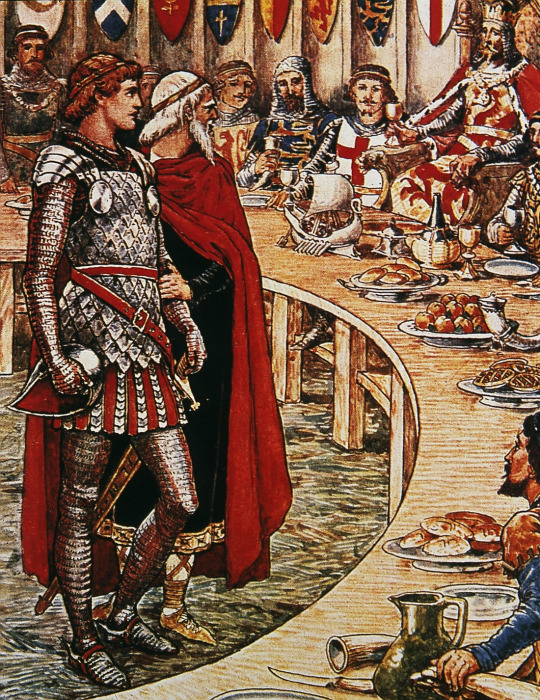
16 notes
·
View notes
Text
Not including Sir Not-appearing-in-this-film for the others couldn't stand a chance against him
#monty python and the holy grail#Monty python#polls#holy grail#Just want to test something. Because I'm sure in the fandom it's between Robin & Galahad#But if it reaches a wider audience either Lancelot or Arthur will win
7 notes
·
View notes
Note
Smash or Pass: "Monty Python and the Holy Grail" character edition
(Same as the Life of Brian character Smash or Pass post, except things gets more medieval in here!)

King Arthur- Smash (he’s literally the ruler of all Britain, that’s so attractive…)
Sir Bedevere- Pass (he would probably burn me at the stake for weighing the same as a duck)
Sir Lancelot- Smash (and suddenly I’m a damsel in need of rescuing. Also he’s played by young John Cleese)
Sir Galahad- SMASH (genuinely the love of my life, the castle anthrax ladies were onto something)
Sir Robin- Smash (hear me out-)
Knights that say Ni- Pass (don’t want them poking around in my shrubbery, if you know what I mean…)
Black Knight- Pass (he’s super stubborn, so there’s going to be conflict in our relationship)
Prince Herbert- Smash (he’s a hopeless romantic and so am I)
(I promise I’m a feminist guys…)
#monty python#monty python and the holy grail#graham chapman#john cleese#michael palin#terry jones#eric idle#70s
24 notes
·
View notes
Note
[Lord I don’t know how to explain the chicanery in this movie, so I’m enlisting Wikipedia. This is what’s happened so far:
In AD 932, King Arthur and his squire, Patsy, travel Britain searching for men to join the Knights of the Round Table. Along the way, Arthur debates whether swallows could carry coconuts, passes through a town infected with the plague, recounts receiving Excalibur from the Lady of the Lake to two anarcho-syndicalist peasants, defeats the Black Knight, and observes an impromptu witch trial. He recruits Sir Bedevere the Wise, Sir Lancelot the Brave, Sir Galahad the Pure, Sir Robin the Not-Quite-So-Brave-as-Sir-Lancelot, and the aptly named Sir Not-Appearing-in-this-Film, along with their squires and Robin's minstrels. Arthur leads the knights to Camelot, but, after a musical number (PS. Highly recommend that song, 👌 ) changes his mind, deeming it "a silly place". As they turn away, God appears and orders Arthur to find the Holy Grail.
Arthur and his knights arrive at a castle occupied by French soldiers, who claim to have the Grail and taunt the Britons, driving them back with a barrage of barnyard animals. Bedevere concocts a plan to sneak in using a Trojan Rabbit, but forgets to tell the others to hide inside it; the Knights are forced to flee when it is flung back at them. Arthur decides the knights should go their separate ways to search for the Grail.
A modern-day historian filming a documentary on the Arthurian legends is killed by an unknown knight on horseback, triggering a police investigation.]
That guy straight up slit that poor dudes throat for like… zero reason.
(I’m not reading allat love ya tho 😘🤞🏾)
Eh I’ve done it before so I can’t say anything
2 notes
·
View notes
Text
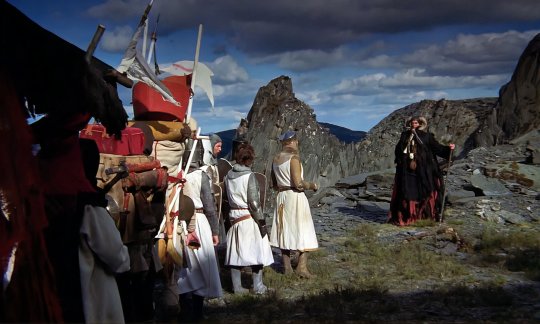
“What manner of man are you that can summon up fire without flint or tinder?”
“I am an enchanter.”
Monty Python And The Holy Grail (1975)
#1975#film#movie#Monty Python And The Holy Grail#Terry Gilliam#Patsy#Eric Idle#Sir Robin The Not-Quite-So-Brave-As-Sir Launcelot#Terry Jones#Sir Bedevere#Michael Palin#Sir Galahad The Pure#Graham Chapman#King Arthur#John Cleese#Tim The Enchanter#The Holy Grail#Cave Of Caerbannog#Camelot#Monty Python#knights
83 notes
·
View notes
Text
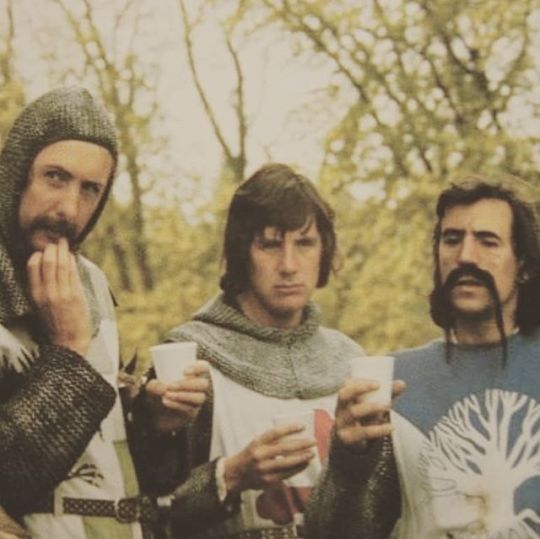
Behind the scenes of Monty Python and the Holy Grail (1975), where no one seems very happy with craft service. Even Terry Jones' mustache looks sad.
#Monty Python and the Holy Grail#Monty Python's Flying Circus#Eric Idle#Sir Robin the not-so-brave-as-Sir Lancelot#Michael Palin#Sir Galahad the Pure#Terry Jones#Sir Bedevere the Wise
198 notes
·
View notes
Text
. i had an idea for a catchy name so i made an arthurian dracula daily. sign up to nightly knights for highlights including me stealing sir bedevere's identity (go along with the bit i beg of you), emails occurring at completely random intervals which can only be described as "when i feel like it", and the constant pushing of my povest o'trischane agenda. first email goes out before the end of the month
77 notes
·
View notes
Text
An Arthurian adaptation need not resemble its source when the creator cares about thoughtful storytelling and themes. This transcends medium and genre. I’m not a snob about “accuracy” so much as a stickler for adherence to the respect of one’s audience through sustained narrative quality.
Examples forthcoming.
Camelot 3000 comic is set in the far future. Everyone is reincarnated. Tristan is reborn as a woman, and has to overcome dysphoria and questioning of sexuality in order to properly embrace their new life with Isolde, another woman. Kay explains that he was unruly all those years ago to deflect criticism off of Arthur and direct it at himself, an attempt to subtly aid his brother in maintaining a positive public image. Guinevere is a military commander whose role in the love triangle remains intact aside from the ending. The fellowship of the Round Table are battling aliens while grappling with their new identities and personal journeys. It concludes after Arthur dies, and Guinevere reveals to Lancelot she is pregnant, but doesn’t know by who. He says he will love the baby regardless. So they escape their doomed fate of the medieval source.
Monty Python and The Holy Grail movie (and musical) takes one of Arthurian Legend’s darkest and most tragic stories and retells it as a comedy. Every trope is subverted to an extreme. King Arthur’s supremacy and the conventions of his story are constantly challenged. Serfs question the Divine Right of Kings and “didn’t vote for” Arthur. The Black Knight denies his inevitable defeat, suffering “but a flesh wound,” until he’s nothing more than a torso and a head. French sentries refuse Arthur’s appeals for entry and mock him from the battlement. Meanwhile Galahad endures the Castle of Maidens only through the help of a queer-coded Lancelot (which becomes explicit in the musical when he marries a man). Not only a complete reversal of their medieval roles, but conflict from Guinevere and Elaine is entirely absent (except in the musical which includes a character named Sir Galahad’s Mom). The group then faces the Bridge of Death. Lancelot contrasts his medieval counterpart yet again by answering a simple question and succeeding, OC Robin the Not-Quite-So-Brave-as-Sir-Lancelot fails an absurdly challenging one, followed by Galahad’s failure of another easy one. It ends with Arthur and Bedevere searching for Lancelot, and ultimately results in their arrest by the police.
High Noon Over Camelot is a folk album that retells the story as a dieselpunk western. The three Pendragons—sheriff Arthur, quick-draw Guinevere, and sharpshooter Lancelot—run Camelot as a polyamorous throuple. The love triangle conflict is turned on it’s head which opens the story up for exploration of side characters and their niches. Arthur’s daughter Morgause is not killed by the Ghouls (Saxons) as he thought but instead raised by them, eventually transitioning to Mordred. The Hanged Man, a robot named Merlin, gives three prophecies: Arthur’s son is alive, Gawain’s hatred of the Ghouls is unjust, and Galahad the preacher should sit in the Siege Perilous. Only Galahad heeds the prophecy. Driven mad by the power of the Siege Perilous, he has visions of the space station’s imminent danger, which can only be helped by restarting the GRAIL system on board. So the Pendragons depart with the Grail Knights, leaving behind Mordred and Gawain in charge of Camelot. Mordred tries and fails to pass a peace treaty between Ghouls and Camelot when a fight breaks out and Gawain goes berserk. A hopeless Mordred ends up abandoning his convictions and heads for the space station. He corners the Pendragons as they reach their goal, the Grail Knights having fallen to get them this far. Mordred kills Lancelot and Guinevere, wounds Arthur, then ejects him into space inside a life-pod. Lastly he crashes the station, killing everyone on board and himself.
The Knights of Breton Court is a trilogy by Maurice Broaddus that retells King Arthur’s story in a modern inner city American setting. Street hustler King attempts to reconcile a group of drug dealers, gangbangers, and well-meaning but lost street kids into a uniform front. All kinds of issues arise to comprise his vision, sometimes borne of character flaws within his crew and sometimes otherworldly forces. In some ways, this series could’ve stood to divert even further from the medieval literature that inspired it, as it suffers from the same pitfalls causing modern readers to drop antiquated literature. The meandering plot, inconsistent pacing, and multitude of characters can read nonsensically to someone unaccustomed to the style. The central thread, King [Arthur] and his goal, is sometimes lost. In trusting Broaddus, I think this criticism relates not to his ability as a writer, but can be traced and attributed Le Morte d’Arthur. Regardless, that’s neither here nor there. The point is that The Knights of Breton Court’s shortcomings are unrelated to its divergence from medieval sources. Although it’s not my favorite, it illustrates beautifully how far a novel can stray while keeping itself firmly under the retelling umbrella. The Indianapolis setting and reimagined personas for the knights is it’s greatest strength, but would be fundamentally broken if Broaddus had stripped it of its original essence. They are intrinsically linked. Also Kay is an unfriendly Rottweiler.
These examples offer thought provoking changes while utilizing the framework of existing characters and their established dynamics/traits to subvert or deepen the meaning behind them. For all the differences between the adaptations and their shared source material, it works, because the creators committed to the bit. This isn’t to say all retellings toe that line effectively.
Cursed is a novel and Netflix series written by Tom Wheeler, illustrated by Frank Miller, and produced by them both. Considering the amount of involvement these two had on both the book and series, it’s safe to assume their creative control was absolute, and each of these mediums fully realized their vision for the story. However, regarding Miller and Wheeler as storytellers with a vision implies they are creatives. It assumes a passion for the project, some semblance of personal expression through art, which is unsubstantiated by the artificial depth of significance displayed in Cursed. The series was green lit before the book even published, so that should give you an indication of the true motivations behind this retelling. It wasn’t made for the love of the source material realized through an artist’s unique perspective, but quickly drawn up and produced to capitalize on the joint products as much as possible.
I will spare everyone a long-winded review of this wretched book and show. They fulfill none of the promises made in the back cover blurb and series description. It’s an insult to the audience’s intelligence. But the point is, the Arthurian elements are not integral to the story, but rather recognizable set pieces and props artificially painted on like a brittle veneer. They exist solely to capitalize on what Miller and Wheeler hoped was an existing audience without the need to develop worthwhile story and attract an audience on their own merits. What they’ve done feels not like inspiration or transmutation, but appropriation of something they neither respect nor care to understand. That is the stipulation, for me, to garner enjoyment from a retelling, regardless of how far it strays from the sources it claims aspects from. An artist must comprehend their material, their muse, their emotional connection to the piece in order to properly manipulate and utilize it. Miller and Wheeler are not artists and their lake is a puddle.
#Arthurian legend#Arthuriana#literary criticism#literary critique#idk what else to tag this as I am ranting#I am not a proper critic I don’t even write goodreads reviews#I just hate how many people in writing groups dismiss arthuriana out of hand bc the image has been tainted#making anything worthwhile takes work and I wish nepotism in publishing and Hollywood didn’t constantly muck it up#somehow arthurian retellings as a genre is both over saturated and in dire need of a rennaissance#it would seem the public opinion at least in writing groups online is poor#and this is entirely the fault of capitalism#Disney remakes their own films and unpublished writers with money get movie deals for weaksauce stories#if you don’t understand that ‘arthuriana’ is not what you’re writing about you need to take a step back#consider arthuriana the genre as well as the subject#but that is not enough to carry a narrative what are you saying with your work what is the theme what are we exploring#I don’t relate to arthurian characters bc I recognize their names I relate bc of the human condition and struggles even when they shift#from story to story it’s okay if it’s new just COMMIT have some authenticity#nobody wants to show their ass when writing anymore it’s pathetic#put your passions into your work or fuck off#Monty Python set out to highlight the joy of comedy with King Arthur and some coconuts and we loved it#Broaddus wrote about his very personal experiences where he grew up discussed race and wealth disparity thru King Arthur as a gang leader#I’m sold on that bc they cared about making it#anyway I am done lol
16 notes
·
View notes
Note
🙂
What are some (say 5 if possible) major differences with the Merlin Lore and the BBC show Merlin?
To make this easier, I’ll list Lore that is, then what the Show has then expand. And I also, perchance, may have ended with 8 rather than 5....
Now, the lore shifts depending on Author, as such, we have examples of different characters doing the same acts (Lancelot and Mordred) while some characters end up with multiple versions of names due to the myths transforming across lands and space and time (Bedivere/Bedwyr/Bédoier/Bedevere or Caradoc/Caractacus/Caradog Freichfras/Carados Briefbras or Walwanus/Gwalchmei/Balbhuaidh/ Gawain/Hauwaine/Gwaine and possibly more important to what I’m referring to Guinevere/Gwenhwyfar/Gwenivar/Gwynnever/Guenevere/Guenever/Gwen)
1. Lancelot and Gwen.
In the show we get the nice blossoming relationship that starts early on. Lancelot is all the things that Gwen comes to love in Arthur, and Lancelot is, as half the characters are, smitten with Gwen. He stands aside, in the show, letting Arthur have her [which is a bullshit interpretation, Gwen has agency, she chose Arthur but whatever]. In the Lore, however, this is more of where Shade!Lancelot shows up, as the Lancelot-Guinevere love story shows up. This is first seen in the 12th century Lancelot, The Knight of the Cart, in which the reader is introduced to adultery being committed with an already married Queen and a knight that was sent to protect her. Now, Chrétien de Troyes’ work invented this affair to counter Mordred-Guinever’s affair (as Mordred is often depicted as Arthur’s nephew in early works), after introducing Lancelot in his earlier work Erec and Enide (roughly 1170).
The Lancelot-Gwen story gets really popular in the 13th century, specifically in France, probably because Lancelot is a french addition, but anyway, this is roughly where we get Sir Thomas Malory’s adaptation which brings in Lancelot as a youthful teen who is knighted by Queen Guinevere and later rescues her from Maleagant (which is similar to The Dark Tower episode in a way) and afterwards the affair between the two eventually leads to the fall of Arthur and themselves. In Malory’s Le Morte d’Arthur Guinevere is often portrayed as, honestly, a bitch [lots of annoying jealousy, deciet, adultery]. Within the works Lancelot falls into Madness and later, once revealed as a betraer of his King (for multiple reasons), Lancelot kills several knights and escapes, but then returns to stop Guinevere’s execution at the stake and in the time of battle, Gaheris and Gareth, brothers of Gawain are killed, Gawain falls into a rage that pressures Arthur to confront Lancelot and eventually causes lancelots death at some point. A very long winded thing that is drawn out and also includes Mordred sometimes.
2. Geoffrey of Monmouth
Not really a ‘difference’, more of a nod to the British cleric from Wales who helped develop and popularise the Arthurian stories. The show has him working the library in Camelot (which is roughly anywhere from 410AD to 1066AD I’d have to imagine with the Anglo-Saxony problems occurring in post-Roman Britania) whereas the actual Geoffrey would have been roughly born 1095, dying maybe 60 years later. His depiction, interestingly, is often that of a bearded old man, not because this would be exactly how he looked, but in the era beards were a show of knowledge and wisdom (and ‘oh look at me I’m old and know things’) which has a standing tradition which goes back to ancient Greece when the beard was a symbol of masculinity and virility and being beardless was a symbol of youth and effeminacy (and possibly further back but I know ancient greek stuff so I’m sticking with my knowledge), although, in the show, he definitely looks maybe 100 but that might be just me looking at him like “wow he’s old.”
Anyway, his works were so influential that there is the idea of Pre-Geoffrey and Post-Geoffrey arthurian works (or rather Pre/Post Galfridian as that is his name in latin and classical languages are how works that clerics wrote are usually done thusly). Historia Regum Britanniae, the wonderful history of the kings of Britain from the settlement of Brutus of Troy, descended from Aeneas, to the Julius Caesar invasions and to real kings and fictional kings. Most of the work is based off other works like Historia Brittonum (attributed to Nennius), Ecclesiastical History of the English People (Bede), and De Exidio et Conquestu Britanniae by Gildas, along with oral works that would be traditionally passed down in communities. Now, it wasn’t his only work that remains prominent in the Series we know, as Prophetiae Merlini (Prophecies of Merlin) are utterances attributed to Merlin which have some popping up relevance in the show. Not much, to be sure, but we do have the White/Red dragon fight from this (with Aithusa/Kilgharrah not actually fighting however, but the symbolism is there).
3. Morgan Le Fey and Lancelot
In the show we briefly get this touched on with Shade!Lancelot doing a heckin bow of loyalty to Morgana (whom shall be referred here as Morgan) and kinda having heart eyes. However, in Prose Tristan, Lancelot is Morgan’s love interest/desire although he refuses her obsessive advances as he is in love with Guinevere. However, Morgan courts, drugs, enchants, and even goes so far as imprisoning Lancelot to keep him with her (in a parallel to Morrígan and Cú Chulainn). Now to the ‘shade’ aspect, there is a nice parallel to Queste del Saint Graal in which, within a vision Lancelot (and the audience) see a vision of Hell with Morgan controlling demons in the afterlife, which is similar, but also wildly different than the necromancy Show!Morgana has done to Shade!Lancelot.
4. The Isle of the Blests
This is the best parallel and difference watchers of the shows can see I’d imagine. Of course, in the show we have the Isle of the Blessed where members of the Old Religion would have gone to worship, the Isle was inhabited by high priestesses of the triple goddess and their Blood Guards and held at one point, most of the artifacts that Arthur and Merlin stumble across (Rowan Staff, Horn of Cathbhadh, Cup of Life which would be better known as the Holy Grail).
In our wonderful vast accounts of Arthurian lore, however, the Isle of the blest, or perhaps the Fortunate isles, is synonymous with the Isle of Apples, or as we more commonly know it, Avalon. Of course, in the show, Avalon was the land of the otherworld, of the sidhe, but in the lore, the isle of Avalon was where women live who know all the world’s magic. Rather, this was also where Morgan lived with her nine sisters. From Geoffrey’s Vita Merlini, we see Morgan connected with Avalon, specifically in the role of a healer to Arthur after having been injured at the Battle of Camlann, and Morgan, as the leader of the nine magical sisters (unrelated to Arthur at this point), heals him after Taliesin delivers him there [Really it’s not until the late 12th century when morgan is transformed into the supernatural elder sister of Arthur].
This account, however, of nine sisters (supposedly named Moronoe, Mazoe, Gluten, Glitonea, Gluten, Tyrone, Thiten, and Thiton) is very similar to the nine Gaulish priestesses or druidesses of Île de Sein, in which the Roman Chronicaler Pomponius Mela noted that the maidens venerated a god of prophecy and were known for their powers of 'sight' and as healers, along with having the ability to shapeshift into animals and raise storms at sea. On the note of sisters, however, it should be noted that Morgan, or rather Morgana, gains multiple different sisters from Morgause and Elaine of Garlot, along with the interesting history that surrounds Gwyar (as either a replacement for Morgause or Anna, a mother of Gawain/Gwalchmei ap Gwyar, and supposedly daughter of Amlawdd Wledig.)
5.Sir Ector Vs King Uther
In many of the lore surrounding Arthurian legends, Arthur is raised by Sir Ector as a brother of Sir Kay after joining the house as a baby to keep him safe from assassins (which Disney’s Sword in the Stone kinda gets at). Often times, when Arthur finally ascends to the throne, Sir Kay rises very quickly in prominence at court (although it’s said Kay has magic of indurance in that “nine nights and nine days his breath lasted under water without sleep” and “when it pleased him he would be as tall as the tallest tree in the forest [...] because of the greatness of his heat, and when his companionswere coldest, he would be as fuel for them to light a fire”). Although, he’s not the best knight around, nor a good role model in his actions. Nevertheless, Sir Ector is, in the works of Robert De Boron and Thomas Malory, given Arthur by Merlin who, with permission (usually or believed) by Uther and Igraine, brought Arthur to safety. Merlin doesn’t reveal the identity of the boy to Ector, and Ector raises him as a son, next to his own. This differs of course from the Princely raised Show!Arthur the audience watches. Not the biggest difference about, for Sir Ector is actually not that big of a ‘player’ in the scheme of their universe, but it is interesting to note nonetheless.
6. Minor Characters: Tristan and Isolde / Elaine of Astolat
Tristan and Iseult/Isolde have an entire prose cycle (Prose Tristan) based around them, and this was limited to a few scenes in the show. Understandable, as we are focusing on Arthurian progression from Prince to King, but the characters are based off the Cornish Knight Tristan falling in love with the Irish Princess Iseult (daughter of another Iseult, cause we love repetitive names in families. Definitely keeps family lines clear to see). Now, some versions have them ingesting a love potion, others have it as true love between them. Nevertheless, Tristan isn’t supposed to be in love with her because he’s delivering her to Cornwal to marry his uncle, King Mark. In one version the potion was supposed to be ingested by Iseult and King Mark to make a love-match between the two, but things got fucked up. Anyway, most times Iseult does marry King Mark and then we got adultery on the side which then the king’s advisors catch onto and try to convict them of. And this does madness stuff and what-not and at some-point you have a Hepheastus moment where King Mark is trying to trap Ares and Aphrodite, sorry, I mean Tristan and Iseult for proof. Tristan is to be hung and Iseult is to be burnt at the stake (or sent to a leper colony or both), anyway, Tristan escapes, rescues Iseult, and now they’re in the woods as outlaws. Which, in the lore they sometime return to have Iseult marry Mark properly as Tristan fucks off to adventure somewhere and Iseult has a happyish marriage until Mark dies and Tristan returns. Anyway -- Kinda similar to what we see, we just have them at the outlaw part of existence when Tristan is cursing the name of his Kingly Uncle and swearing off nobility.
Elaine of Astolat/Ascolat supposedly is a figure who dies from unrequented love of Lancelot - bear with me - and drifts down the river to Camelot in a boat in the Mort Artu 13th century French romance - bear with me - while clutching a lily in one hand and a letter in the other. Elaine is found by King Arthur’s court, the letter is read, Lancelot feels ashamed and pays for a burial. The reason I mention this is it’s a similar death scene to many of the imporant characters we see die in BBC Merlin, and in particular, Lancelot and Freya. One, very important to Merlin, not quite an unrequited love, but near enough. The Other, the very man who broke Elaine’s heart in the prose.
7. Princess Gwenhwyfar
I’m using this name as a nod to The Dragon’s Call, in which when Gwen introduces herself to Merlin in the stocks, that is what the subtitles say. The lore surrounding Gwen is wild. She is a villainour opportunistic traitor. She is a loving wife. She is ‘if she were a spice she’d be flour’. And she is a fatally flawed but noble and virtuous lady. Too many versions. Each author changes her character the most as compared to literally all others. The biggest shift from Merlin’s show to the lore, however, is Gwen is never a servant/maid, and she is Elyan the White’s sibling. The main thing here, I’d say, is her father King Leodegrance (in some versions) and sister Gwenhwyfach (false Guinevere). Different traditions have her with different family (Cywryd of Gwent / Gwythyr ap Griedawl / Gogrfan Gawr (specifically Gwenhwyfar ferch Ogrfan Gawar Drwg yn fechan, gwaeth yn fawr or ‘Gwenhwyfar, daughter of (G)Ogrfan Gawr, bad when little, worse when great ) / Garlin of Gore / King Madaglan (although he is an uncle I think?)) Lots of fathers nevertheless. Too many. Head hurts trying to look at genealogy for Gwen. Now, in addition to this, as mentioned above, Elyan the White (Helyan le blanc/Elain/Elayn/Helain/Hellaine/Helin - the pale / le blank) is the son of the Knight Bors the younger, and his mother Claire, daughter of King Brandegore. Anyway, with Elyan, he doesn’t interact much with Gwen until having to help his cousin Lancelot rescue her after the affair is exposed, then also joins Lancelot in exile, and later, (following the vulgate cycle) he becomes Emperor of Constantinople.
8. Excalibur/Caliburn
Arguablly these are the same sword with different names. However, typically, Caliburn is the Sword that is stuck in the stone while Excalibur is given by the Lady of the Lake after Caliburn breaks in a fight. Although, then again, naming issues. Caliburn is the latin from the Breton Kaledvoulc’h, Welsh Caledfwlch, and Cornish Calesvol. The name Excalibur derives from the Caledfwlch, however the two are still depicted as different swords most often. Generally, the sword in the stone is the whole divine right of kings bullshit that keeps monarchy in power for most of history. Sometimes when Caliburn breaks in a fight, Merlin takes the same sword to the Lady of the Lake to make it whole again, reforged into Excalibur (nearly seen in the name ex-calibur(n) - out of caliburn). From what we watched back in… 2009-2013+ Excalibur is forged by Tom, Gwen’s father, breathed magical by Kilgharrah, given by Merlin (accidentaly to Uther), tossed into the Lake, returned by Freya (thus given by the Lady), then struck into Stone to give Arthur belief that he had god’s will on his side because of old prophecies that Merlin definitely made up but made everyone believe.
#bbc merlin#merlin#Vita Merlini#geoffrey of monmouth#Bede#history#comparison#analysis#Prophetiae Merlini#Historia Regum Britanniae
10 notes
·
View notes